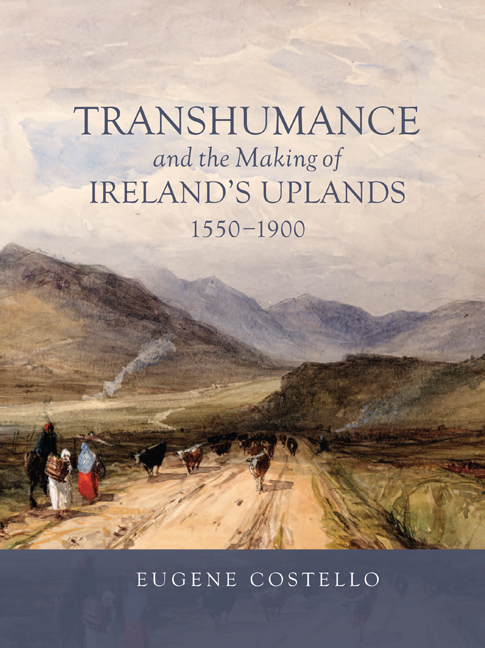Book contents
- Frontmatter
- Contents
- List of Illustrations
- Preface and Acknowledgements
- Note on Chronology
- Introduction
- Chapter 1 Seasonal Movement and Settlement in A World of Pastoralism
- Chapter 2 Imagining Movement: Past and Present Views of Transhumance in Ireland
- Chapter 3 Seasonal Sites in Context: Summer Pastures of the Carna Peninsula
- Chapter 4 Connected Places: Home and Booley in Gleann Cholm Cille Over Time
- Chapter 5 Altitude and Adaptation: Evolving Seasonal Settlement in the Galtee Mountains
- Chapter 6 Herders and Historical Forces, 1600–1900
- Conclusion
- Bibliography
- Index
Chapter 6 - Herders and Historical Forces, 1600–1900
Published online by Cambridge University Press: 01 October 2020
- Frontmatter
- Contents
- List of Illustrations
- Preface and Acknowledgements
- Note on Chronology
- Introduction
- Chapter 1 Seasonal Movement and Settlement in A World of Pastoralism
- Chapter 2 Imagining Movement: Past and Present Views of Transhumance in Ireland
- Chapter 3 Seasonal Sites in Context: Summer Pastures of the Carna Peninsula
- Chapter 4 Connected Places: Home and Booley in Gleann Cholm Cille Over Time
- Chapter 5 Altitude and Adaptation: Evolving Seasonal Settlement in the Galtee Mountains
- Chapter 6 Herders and Historical Forces, 1600–1900
- Conclusion
- Bibliography
- Index
Summary
This chapter discusses the evolving nature of seasonal movement and settlement in the three study areas in the context of major social, demographic and economic trends that set in from the seventeenth century. It examines the role of elites, first of all, and demonstrates how their level of concern with the management of upland pastures and cattle not only changed over time but varied across Ireland. In doing so, it provides a timely regional characterisation of the socio-political power structures in which subaltern peasant farmers practised transhumance over the course of the post-medieval period. With that in mind, it is possible to explore their adaptive capacity as population and land-use pressures became more noticeable in the Irish landscape. The (re)organisation or cessation of seasonal movements and the encroachment of farmers on upland commons all provide subtle indicators of interaction with these trends, and above all how people dealt with and contributed to them at a local landscape level.
Yet transhumance in this period does not simply echo wider historical processes. It also contains a hidden history of non-elite rural society. Thus the chapter examines the pragmatic approach to dwelling shown by herders as they made a seasonal home out of the hills, considering environmental as well as chronological factors in the morphology of booley sites and comparing their layout with that of contemporary permanent settlements. Furthermore, it highlights the role of transhumance in reproducing the socio-cultural structure of rural communities from generation to generation, particularly through delegation of upland herding tasks to young girls and women. The gender- and age-specific nature of participation in seasonal removals by the nineteenth century was, however, partly related to changes in market demand that tenant farmers became cognisant of. I therefore examine how the currents of capitalism changed livestock farming in uplands – in some cases conflicting with the idea of transhumance, in others encouraging it. The chapter's last section reveals how the disruption of customary grazing rights and elite-induced reorganisation of estates contributed to the final decline of seasonal movement.
THE ROLE OF THE ELITE IN CHANGING RURAL SOCIAL STRUCTURES
The Gaelic and Hiberno-Norman elites exerted significant influence over how transhumance operated before the mid-seventeenth century.
- Type
- Chapter
- Information
- Transhumance and the Making of Ireland's Uplands, 1550–1900 , pp. 133 - 177Publisher: Boydell & BrewerPrint publication year: 2020



